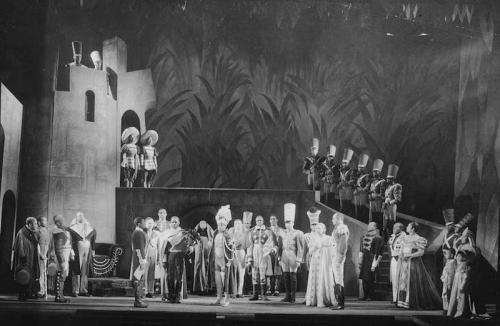In 1935, in the middle of the Great Depression President Franklin Delano Roosevelt’s Administration created the Works Progress Administration Federal Theatre Project (FTP) as part of the New Deal economic recovery program. Negro units, also called The Negro Theatre Project (NTP), were set up in 23 cities throughout the United States. This short-lived (1935-1939) project provided much-needed employment and apprenticeships to hundreds of black actors, directors, theatre technicians, and playwrights. It was a major boost for African American theatre during the Depression era.
These units were situated throughout the country in four geographical sectors. In the East, the most productive units were located in New York City, New York, Boston, Massachusetts, Hartford, Connecticut, Philadelphia, Pennsylvania, and Newark, New Jersey. In the South, units were placed in Raleigh, North Carolina, Durham, North Carolina, and Birmingham, Alabama. In the Midwest, they were situated in Chicago, Illinois, Peoria, Illinois, and Cleveland, Ohio. In the West, units were in Seattle, Washington, and Los Angeles, California.
The best-known and most active FTP was The New York Negro Unit (1935-1939). Located at the Lafayette Theatre in Harlem, it staged some 30 productions. Two white directors, John Houseman and Orson Welles, headed it in 1935. Three black directors, Edward Perry, Carlton Moss, and H. F. V. Edward replaced them in 1936. The unit’s most popular production was the Haitian, or “voodoo,” Macbeth (1935), an adaptation of Shakespeare’s play set in the Caribbean, under the direction of Wells. Other productions included Frank Wilson’s folk drama Walk Together, Children (1936), which described the forced deportation of 100 African American children from the South to the North to work for menial wages. Arna Bontemps and Countee Cullen’s The Conjur Man Dies (1936), a farcical mystery in three acts, dramatized Rudolph Fisher’s mystery-melodrama. Also in 1936, J. Augustus Smith and Peter Morrell co-authored Turpentine, a social drama in three acts and ten scenes which focused on the evils of the Southern labor camp system. George MacEntee’s The Case of Philip Lawrence (1937) was a courtroom melodrama. Haiti by William DuBois (not to be confused with W.E.B. DuBois), appeared in 1938 as a historical drama about the overthrow of a Haitian government. The Negro Youth Theatre, a popular subdivision of the New York Negro Unit, produced Conrad Seiler’s social drama Sweet Land (January 1937), which toured the streets of New York with the production during the following summer.
The Newark Negro Unit, in combination with the white New Jersey unit, produced one of the most successful FTP productions by a black author, The Trial of Dr. Beck. Hughes Allison’s play was a courtroom melodrama about color stratification among upwardly mobile blacks. The Trial was produced at Union City and Newark, New Jersey in 1937 and then transferred to the Maxine Elliott Theatre on Broadway, where it ran for four weeks.
The Philadelphia Negro Unit produced Prelude in Swing, a 1939 musical documentary by Carlton Moss. The Boston Negro Unit was directed and run by Ralf Coleman, also a playwright and one of the leading performers. His brother Warren Coleman, and H. Jack Bates, the main resident playwright, assisted him. Broadway and film actor Frank Silvera was also a member and leading actor with this unit. Among the plays this unit produced (c. 1937-1938) were Bates’s Cinda, a black version of Cinderella, Dear Morpheus, a fantasy of love and marriage, Streets of Gold, Black Acres, The Legend of Jo Emma, The Lost Disciple, and Coleman’s Swing Song. The Hartford Negro Unit produced Trilogy in Black by Ward Courtney in 1937. The Raleigh Negro Unit produced Heaven Bound, a black morality play adapted by Laura Ward in 1936.
Shirley Graham (later Mrs. W.E.B. DuBois) headed The Chicago Negro Unit from 1936 to 1939. This unit rivaled the New York unit in the originality, popularity, and variety of its offerings. The Chicago unit’s most acclaimed production The Swing Mikado (1938), was a jazz version of the Gilbert and Sullivan operetta, which was a hit both in Chicago and New York City. Other productions by this unit included Lew Payton’s Did Adam Sin? (1936), Little Black Sambo (1937), a children’s operetta, and Theodore Ward’s drama on the Depression, Big White Fog (1938).
In the Far West, The Seattle Negro Unit’s (1936-1939) play production over four seasons (1936-1939) was boosted greatly by the presence of playwright-in-resident Theodore Browne. The unit staged four of his plays, including Lysistrata, an African American adaptation of Aristophanes’ comedy, and Natural Man, a dramatization of the John Henry legend. Go Down Moses was a play about Harriet Tubman and her involvement in the Underground Railroad. Swing, Gates, Swing was a musical revue. The Los Angeles Negro Unit produced two plays by black playwrights. John Henry by Frank B. Wells in 1936, about the legendary railroad worker, and Run Little Chillun’! in 1938-1939), a revival of Hall Johnson’s folk drama that originally appeared on Broadway in 1933.

